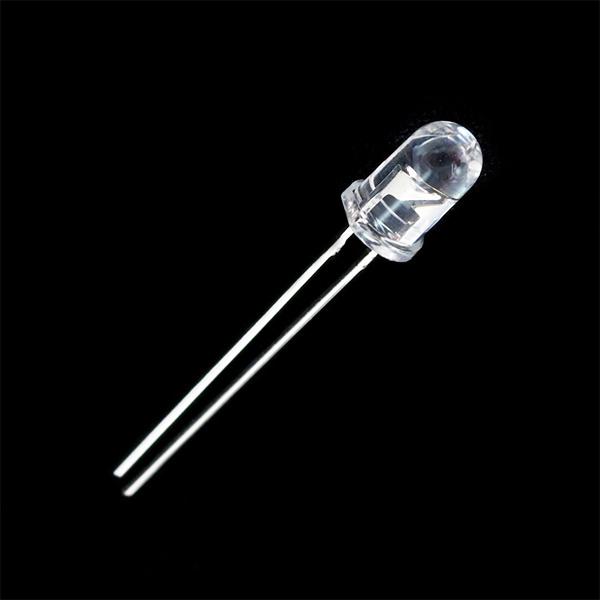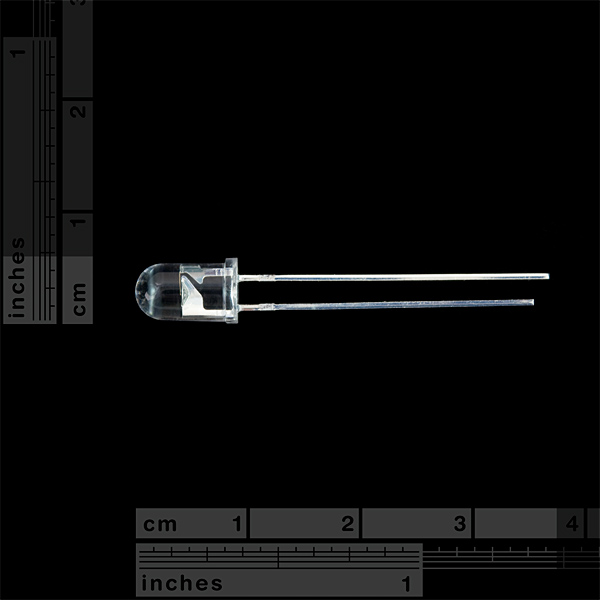LED - Infrared 850nm
This is a very simple, clear infrared LED. These devices operate between 840-850nm and work well for generic IR systems including remote control and touch-less object sensing. Pair them with any of our IR receivers (see Related Items below). 1.5VDC forward voltage and 50mA max forward current.
- Datasheet
- Illumitune Project (tutorial) (video)
- LED Tutorial
LED - Infrared 850nm Product Help and Resources
Core Skill: Electrical Prototyping
If it requires power, you need to know how much, what all the pins do, and how to hook it up. You may need to reference datasheets, schematics, and know the ins and outs of electronics.
Skill Level: Rookie - You may be required to know a bit more about the component, such as orientation, or how to hook it up, in addition to power requirements. You will need to understand polarized components.
See all skill levels
Comments
Looking for answers to technical questions?
We welcome your comments and suggestions below. However, if you are looking for solutions to technical questions please see our Technical Assistance page.
Customer Reviews
3 out of 5
Based on 1 ratings:
Needs Labeling
I bought this product along with the 950 nm infrared LED, and they came together in a package without any labeling, making it hard to tell which was which. A comment on the product page recommended lighting them both in a dark room, but I still did not see any difference. I eventually figured out which was which by measuring their turn-on voltages directly with a power supply and voltmeter, but I would have appreciated a simple sticker on each of the bags to save me that trouble.



What wattage does this give off?
I wired up 3 of them to make a night vision webcam for my aquarium.
I had them going at about 45mA but 3 was only sufficient enough to illuminate a small area of the tank.
http://img689.imageshack.us/img689/5754/img1948m.jpg
Try implementing a 2N3904 transistor like this:
http://www.ladyada.net/make/tvbgone/design.html
Scroll down to IR-Driver Transistor
make laser keyboards wooo
Excuse my noob question, but I'm confused, what is the difference between the IR LED 850nm and 950nm? Any change in the distance? : S
The difference is effectively the color of the light that it outputs, in the same way that a green LED is different than a red LED. Since both 850 and 950nm are infrared, assuming you're human, you can't see the difference (a snake could probably tell you). But in terms of selecting one or the other, you should get the one that corresponds to what your receiver is looking for. Check those specs first, then get the matching LED.
Mike's right, there's not much difference as far as the IR usage so long as you match your receiver. If it doesn't matter for for the receiver, one thing I ran across is that the 850nm might be useful to know, yes most of the light is out of the visible range, but without a filter or anything, you'll likely be able to see a very faint red glow from them in the visible range. I'm actually about to take advantage of this because out of laziness I want an IR illuminator that I can visually confirm has power without pulling out my camera on my phone.
To drive this off a 5V Arduino pin, what resistor should I use? Thanks!
If you don't mind running it at 20mA, then the usual calculations apply: R = (Vsupply - Vf) / If: R = (5V - 1.5V) / 0.02 = 175 Ohm. Nearest R12 series: 180 Ohm.
The reason I mention the 20mA is because the Arduino pins don't really want to deliver the full 50mA that these are rated for (see also the Illumitune tutorial link). This may or may not be an issue for your purposes - at 20mA it'll be a fair bit weaker (the datasheet doesn't specify how much weaker, though).
If you did want to drive it at 50mA, you'll want to use a transistor or the like to toggle power to the LED. Fortunately, SparkFun sell a kit that has everything you'd need - Max Power IR LED Kit except it uses the 950nm IR LED, so you'd have to swap that out with this one if you need the 850nm, or build your own circuit based on the Max Power schematic (it is a pretty simple one, but if you don't already have the components laying around, that kit is neat and tidy, and a timesaver).
When will this item be back in stock?
This one (and not the 950nm) is within spec for IrDA.
Hello, I'm making a infrared light pen, Can someone sanity check this for me?
According to ledcalc.com : (Supply Voltage 1.5v Voltage Drop Across LED 1.4v Desired LED Current 50ma ) apparently I need a 2.2 Ohm resistor? would this be correct running off a AAA battery?
I'm looking to produce as much light possible from the led. I can change the power source if need be. is this calculation correct?
@Xirvin you can also use most mobile phone cameras to see if its on. :)
In case you were in a similar situation as me. I bought this led with the 950nm IR Led. I was confused as to what led was the 950nm and 850nm. One way to tell you have the 850nm is to place it in a dark room you should see this led red while on when seeing from the top of the tip.
Don't stare for too long.
I am starting this project for a buddy: http://www.sparkfun.com/news/540
http://www.instructables.com/id/The-EyeWriter/
I've always assumed that because the LEDs have a much wider beam angle than LASERs (58 degrees according to the post above us), that even two of these mounted 10cm from the eye wouldn't be enough to cause any sort of measurable damage. However I've been searching the internet looking for hard evidence and most of the posts claiming Near IR will cause damage are referring to much more powerful lasers, very powerful heat lamps and such. All the posts claiming it's safe to stare into your computer mouse near IR LED seem to be written by 13 year olds on Yahoo Answers (go figure).
Do you have any hard evidence to back up your claim that staring at these for extended periods of time can cause significant damage, or are you going off the same gut instinct I feel about staring into a light my iris can't react to?
I'll probably just go ahead with the project.
Unlike with visible light, your eyes will not constrict when exposed to infrared light, I.E your body doesn't even try to protect itself from the light, even though it may be intense enough to cause damage...
what is the beam angle of this product
According to the datasheet diagram it's about 58 degrees, or ?29 degrees from center.